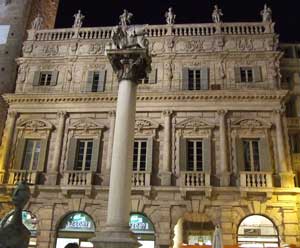Verona is a pleasant city to explore on foot, armed with a map and a little background information. The town has a few important tourist sights, and plenty of other churches, monuments and things to see if you’re in town for a longer stay. There’s also an open-top bus tour, which can’t get into the narrowest lanes, but is an option for travelling between sights and seeing the wider city.
Practicalities, combined tickets and saving money
There are various ways to save money on entrance fees in Verona, so it’s worth doing a spot of research before beginning your Verona sightseeing. The best deal of all is a very useful ticket called the Verona Card, valid for either one or three days, which includes admission to all the important sights – a massive saving – and includes journeys on local transport. There’s an official Verona Card website (see links panel) where you can check the latest prices. If you happen to be in Verona between October and May on the first Sunday of the month, you can take advantage of a special cheap admission fee; most of Verona’s museums and sights only charge €1. At other times, there are generally discounts for children, students and senior citizens. Four of the city’s most important churches (the Duomo, San Zeno, Sant’Anastasia and San Fermo) can be visited on a combined ticket, with a reduction for senior citizens. Several museums also offer combined tickets for two or three attractions.
Information and basic city centre maps are available at the tourist information offices; one along the city wall by the Arena at Piazza Brà and another at the railway station. A map will be extremely useful, as Verona is poorly signposted. You can buy the Verona Card at the tourist information office.
The museums and attractions of Verona are mostly open all week, except for Monday afternoons. Opening hours vary according to the time of year and (in the case of the Arena) the opera season, so if you’re visiting on a tight schedule, try to avoid Mondays and look up the latest opening times in advance.
Things to see
Piazza Brà and the Roman Arena
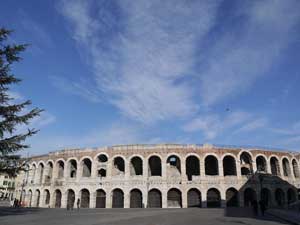
Verona’s historic centre (centro storico) covers a fairly large area, neatly enclosed within a bend of the Adige river. The best place to begin sightseeing is in Piazza Brà, a large open square where visitors are greeted by the town’s most remarkable sight, the Arena. The Arena, a huge Roman amphitheatre, was Roman Verona’s principal entertainment venue, with seating for around 30,000. The main part of the oval structure is well preserved, though an outer ring of arches is almost lost. Open to the public all year round, the Arena also hosts a high-profile summer opera season which attracts cultural tourists from all around the world. Facing the Arena is the Liston, a strip of piazza popular for promenading, lined with attractive historic buildings. From alongside the Arena, tourists and locals stroll along Via Mazzini, an elegant marble-paved pedestrian shopping street which leads to Piazza Erbe.
> More about the Arena and the opera season
Piazza Erbe and Piazza dei Signori
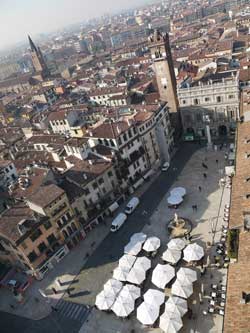
Piazza Erbe is a long and beautiful piazza lined with handsome palazzi and dotted with sculptures, gossiping locals, market stalls and cafe tables. It’s a charming and photogenic spot, and when you arrive here it feels like the real heart of the city. This is a very good point for refreshments and a rest while you absorb the Veronese atmosphere and consider the next stage of your itinerary.
An archway, under which is suspended a whale’s rib bone, leads from Piazza Erbe into Piazza dei Signori. Although the site of Verona’s civic power, the square feels rather tucked away despite its proximity to everything else. Buildings of the 12th to 17th centuries comprise the four sides, none of which makes the remotest concession to its adjoining neighbour, as if their successive architects were too disdainful to bother. The resulting square, not particularly large, looks more like a consequence than a unified conception (unlike the grandly extrovert piazzas of Venice, Pisa or Siena). Yet the buildings are so good you could spend a long time studying each in turn. In the centre of the square is a proud statue of Dante, who found refuge in Verona. Another square, even smaller, lies alongside: the Corte Mercato Vecchio which features a grand external staircase.
The Torre Lamberti is the high belltower rising above Piazza Erbe and Piazza Signori. It offers great views over the town and hills, reaching as far as the Dolomites, capped with snow in winter. The tower is included in the Verona Card, but there’s an extra small charge for using the lift. It’s worth paying this to save yourself some of the climb – but be aware that even using the lift, you still have to climb a good many steps to reach the final upper level. At the top of the tower, the sides are protected by netting, so photography is easier from a terrace lower down.
Scaligero tombs
The most famous family in the history of Verona – other than the Capulets and Montagues, of course – was the Della Scala, or Scaligero family. This dynasty ruled Verona in the thirteenth and fourteenth centuries, earning a reputation for ruthlessness but also as important patrons of the arts. The name, in each of its versions, means something like ‘of the staircase’ and the family’s emblem, which you’ll see around town, is a ladder. Even nowadays in Italy the adjective ‘scaligero’ is still used to describe Verona and its citizens. The Scaligero family tombs are an important stop on a Verona sightseeing tour. Called the Arche Scaligere, the memorials are grouped outside the little church of Santa Maria Antica, just off Piazza dei Signori. Look out for the ladder emblem and also for the dog iconography – several of the family were known by ferocious canine names, from Mastino (Mastiff) to Cangrande (Big Dog). Two of the equestrian statues are copies; you can see the originals at the Castevecchio (see below).
Around the centre of Verona
Verona’s extensive centro storico is remarkable for its number of attractive lanes and historic buildings. One of the most appealing streets is Via Sottoriva, 20 yards in from the river just south of the Church of Sant’ Anastasia. This lane is exceptional in having on its west side a series of low arcades running almost the length of the street. Once there were watermills along this stretch of the river. Nowadays around Via Sottoriva you’ll find several popular hostelries, some with tempting outside tables. The old streets near the Adige around Via Sottoriva and Ponte Pietra have a lot of charm and retain a medieval atmosphere, apart from the ever-intrusive cars.
Two impressive Roman gateways still stand guarding the entrances to the old town: Porta Borsari (dividing Corso Porta Borsari and Corso Cavour), which is very well-preserved and several storeys high, and the Porta dei Leoni (at the end of Via Cappello), which is more fragmentary but still impressive, and is near an uncovered stretch of Roman road. A Roman triumphal arch, the Arco dei Gavi, can also be seen alongside the Castelvecchio.
Another Roman legacy is Verona’s most picturesque bridge, the Ponte Pietra, ‘Bridge of Stone’. Dating back to the Roman era and partially rebuilt in the Middle Ages, it was destroyed in the Second World War (by retreating German forces) and rebuilt afterwards with as many of the original materials as could be salvaged from the river.
Roman theatre and archaeological museum
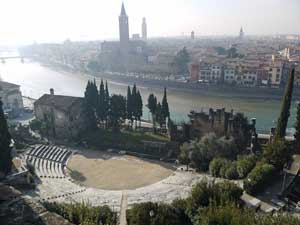
The town’s main archaeological museum is located at the Roman theatre, the Teatro Romano, situated in a panoramic spot over the river Adige from the town centre. From the theatre, take the lift up to the museum, which is housed in a former monastery. There are some interesting exhibits, including a fine bronze head discovered in the gravel bed of the river. The theatre would have been a much more civilised entertainment venue than the Arena; this is where Verona’s ancient citizens would have seen plays rather than the bloody gladiatorial combats hosted over the river. Plays are still put on here nowadays, in the summer.
If you are very interested in Verona’s archaeological relics, you may also wish to visit the Museo Lapidario Maffeiano by the arches leading into Piazza Brà. This is a collection of ancient sculpture, notably a great number of tombstones, including one or two touchingly amateurish memorial inscriptions.
Castelvecchio
Verona’s principal art gallery is housed in the Castelvecchio, the fourteenth-century castle of the Della Scala family. This manageably-sized fortress is an attractive place to visit, and stretches of fortification can be accessed during the museum itinerary. The exhibition begins with sculptures and continues past a rich collection of paintings, some weapons and other oddments. There is some elegant fourteenth century jewellery in a case along with the sword found in Cangrande’s tomb in 1921. Highlights among the paintings on display are a Jacopo Bellini St. Jerome and a charming Madonna seated in a rose garden surrounded by birds and flowers, attributed to Stefano da Verona. The gallery also houses works by Tintoretto, Carpaccio, Veronese and Mantegna. Look out for an unknown German painter’s quaint illustration of the Orpheus story, and Cristo Risorto by Jacopo da Valenza (around 1500), depicting some haunting modernist faces. The eminent Italian architect Carlo Scarpa designed the exhibition layout, and the museum is somewhat over-proud of this (personally I think it could do with a revamp). Look out for the original sculptures from the Della Scala tombs, one housed in the castle’s clocktower and the other poised forlornly alongside a covered walkway.
Verona’s churches
Verona has several important churches which are worth visiting. If you don’t have a Verona Card, the combined ticket for five of the most notable churches (the Duomo, San Zeno, San Lorenzo, San Fermo and Sant’ Anastasia) is good value for anyone keen on churches (or art), especially as you don’t need to do them all on the same day. The Basilica of San Zeno has a beautiful west front ideally seen in full afternoon sunshine, a big unspoilt Romanesque interior, a lot of dawn-of-Renaissance frescoes, and the relics of the town’s patron saint. Sant’ Anastasia has a lofty interior which is suprisingly light and charmingly decorated. The building was begun in the thirteenth century and is largely Gothic in style. There are some charming frescoes in the church, including a lovely fresco of St. George by Pisanello, high above a chapel to the right of the altar. Don’t miss the two carved water fonts inside the entrance – the oldest one, on the left, portrays a fifteenth-century ‘lucky’ hunchback. The Romanesque San Lorenzo on Corso Cavour has a charming arcaded and brick-striped interior, some fragmentary frescoes and an unusual sight: its original women’s gallery. Its narrow interior has a pleasant timeless atmosphere of devotion. Verona’s cathedral, the Duomo, is a memorable striped Romanesque building. Look out for the memorable carvings around the two main entrances. There are a couple of other important sites within the Duomo complex, the cathedral’s two predecessors: the old church of Sant’ Elena and an even older palaeo-Christian basilica. However, the doors to these, inside the Duomo, are not always open.
Along with Sant’Anastasia and San Zeno, one of the most interesting of Verona’s churches is San Fermo, which is a fascinating hotch potch of styles and history. A very early church was built on the site of a sixth-century martyrdom. Then another church was built and then another on top of that. The eleventh-century Romanesque church, underneath the present church, was opened up again in the twentieth century and is very atmospheric, with really old, naive-looking, frescoes on its low walls and columns. Recent excavations have uncovered parts of the older building, including some steps leading to the saints’ shrine, which can be seen under the floor. Back up in the more ‘modern’ church there are still lots more layers of history to uncover. The walls are covered with colourful frescoes, some interrupted by later monuments and tombs. There’s a good Crucifixion above the entrance. The best sight though, is in a side-chapel off the left transept, where during recent works, frescoes were discovered underneath the chapel’s ornamental marble and paintings. Now the later paintings are moved aside from their marble surrounds, so visitors can see the marvellous early frescoes underneath, relating the story of St. Anthony of Padua, to whom the chapel is still dedicated and who is also the subject of a later painting by Liberale da Verona. It is fascinating to see in action how these churches have been changed, added to and embellished over the centuries.
Romeo and Juliet sights
Shakespeare’s characters Romeo and Juliet didn’t exist, and it is extremely unlikely Shakespeare ever set eyes on Verona. However, Verona certainly had feuding medieval families, and for the local tourist industry the opportunities were just too good to miss.
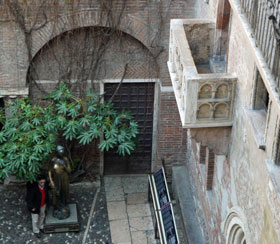
While the exterior is free to view, the paying attraction called the Casa di Giulietta – Juliet’s House – is really only worth visiting if you’re an obsessive or have already paid for the Verona Card combined ticket. This house does have historic origins and is indeed believed to have been inhabited by a family called Capelletti. Its current appearance, though, dates largely to the first half of the twentieth century, when it was ‘restored’ to match Shakespeare’s tale, with a marble balcony added. The entrance is on Via Cappello, off Piazza Erbe, and you can easily spot the gateway as it is covered in the ‘romantic’ graffiti of legions of teenage exhibitionists. Inside is a little courtyard, generally filled with photo-snapping tourists, and a bronze statue of the teenage Juliet. It may seem distasteful, but tourists have instituted the ‘tradition’ of rubbing one of the statue’s breasts, while posing for photographs. The real sight is just above the courtyard: Juliet’s balcony. It needs inverted commas, of course, but tourists don’t seem to mind the gulf between fictional character and random real place. Inside, the house is nicely presented as a stripped-down fourteenth-century dwelling, with various Romeo and Juliet-related oddments on display: pictures, film costumes etc. There’s not a great deal to see, but you can get an idea of the period building, and of course you can stand on that balcony. It’s free to enter the courtyard and since it’s so central, I’d suggest even the most sceptical of tourist pops in to have a free glimpse of the balcony – the eager tourists and graffiti are a fascinating sight in their own right.
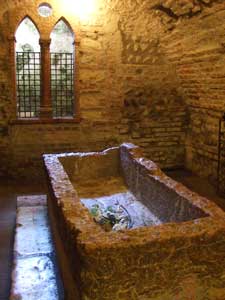
‘Juliet’s tomb’, the Tomba di Giulietta, is a short walk from Piazza Brà. It’s a bit out of the centre and only really worth a visit if you’re very keen. In the surroundings of a former religious foundation, you’ll find some modern sculpture, a exhibition of salvaged fresco fragments, and a basement full of Roman jars. What tourists come for, though, is a random empty stone sarcophogas on display in a crypt within a pleasant little cloister. Eager tourists can post letters to Juliet in a special (it must be very special) postbox.
> Read about the best hotels in Verona
Useful external links
Veneto destinations
- Veneto region
- Abano Terme
- Asolo
- Bassano del Grappa
- Brenta Canal
- Caorle
- Castelfranco Veneto
- Chioggia
- Cittadella
- Concordia Sagittaria
- Conegliano
- Cortina d’Ampezzo
- Lido di Jesolo
- Malcesine
- Marostica
- Monselice
- Montegrotto Terme
- Padua
- Portogruaro
- Rovigo
- Sottomarina
- Treviso
- Venetian Lagoon
- Venice
- Verona
- Vicenza
- Veneto art & architecture itinerary
- Veneto villas – Vicenza: La Rotonda & Villa Valmarana ai Nani
- Veneto villas – Villa Pisani & Villa Foscarini Rossi, Strà
- Venice Airport
- Treviso Airport
